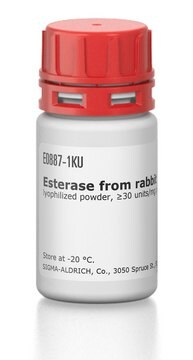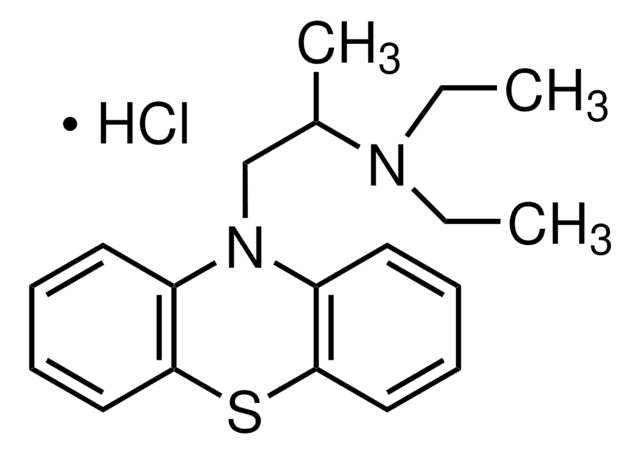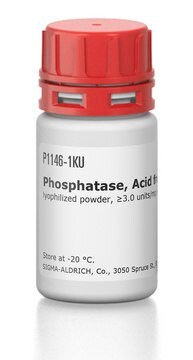E0162
Carboxylesterase 1 isoform c human
recombinant, expressed in baculovirus infected BTI insect cells
Synonyme(s) :
Carboxylesterase 1 human, carboxylesterase, esterase
Se connecterpour consulter vos tarifs contractuels et ceux de votre entreprise/organisme
About This Item
Produits recommandés
Produit recombinant
expressed in baculovirus infected BTI insect cells
Niveau de qualité
Forme
liquid
Concentration
≥0.3 mg/mL
Conditions d'expédition
dry ice
Température de stockage
−70°C
Vous recherchez des produits similaires ? Visite Guide de comparaison des produits
Description générale
Carboxylesterase 1 (CE1) is a member of a large multigene carboxylesterase α,β-hydrolase family. It is majorly expressed in the liver. CE1 comprises an αβ domain, a central catalytic domain and a regulatory domain.
Application
Carboxylesterase 1 isoform c human has been used as a reference standard in carboxylesterase activity from the mussel for comparison of substrate specificity and inhibition studies. It has also been used as a commercial recombinant protein for the methodological validation of environmental chemical-based inhibition studies.
Actions biochimiques/physiologiques
Carboxylesterase enzymes are responsible for the hydrolysis of ester- and amide-bond-containing drugs such as cocaine and heroin. They also hydrolyze long-chain fatty acid esters and thioesters. Carboxylesterase 1 (CE1) catalyzes the formation of cholesteryl esters from cholesterol and fatty acids. Through a transesterification reaction, CE1 also mediates the generation of fatty acid ethyl esters (FAEEs). It also hydrolyzes aromatic and aliphatic esters with preference to small alcohol groups and bulky acyl groups. CE1 metabolizes drug esters and amides carbamates. It participates in the detoxification of environmental toxicants and carcinogens and is useful in pharmacokinetic studies for evaluating pro-drugs.
Propriétés physiques
This product is offered in a volume of 0.5 mL.
Définition de l'unité
One unit will hydrolyze one nanomole of 4-nitrophenyl acetate per minute at pH 7.4 at 37 °C.
Mention d'avertissement
Danger
Mentions de danger
Conseils de prudence
Classification des risques
Resp. Sens. 1
Code de la classe de stockage
11 - Combustible Solids
Classe de danger pour l'eau (WGK)
WGK 1
Point d'éclair (°F)
Not applicable
Point d'éclair (°C)
Not applicable
Faites votre choix parmi les versions les plus récentes :
Déjà en possession de ce produit ?
Retrouvez la documentation relative aux produits que vous avez récemment achetés dans la Bibliothèque de documents.
Les clients ont également consulté
Montserrat Solé et al.
Environmental toxicology and pharmacology, 82, 103561-103561 (2020-12-12)
Carboxylesterases (CEs) are key enzymes which catalyse the hydrolysis reactions of multiple xenobiotics and endogenous ester moieties. Given their growing interest in the context of marine pollution and biomonitoring, this study focused on the in vitro sensitivity of marine invertebrate
Jihong Lian et al.
Protein & cell, 9(2), 178-195 (2017-07-06)
Mammalian carboxylesterases hydrolyze a wide range of xenobiotic and endogenous compounds, including lipid esters. Physiological functions of carboxylesterases in lipid metabolism and energy homeostasis in vivo have been demonstrated by genetic manipulations and chemical inhibition in mice, and in vitro
Masakiyo Hosokawa
Molecules (Basel, Switzerland), 13(2), 412-431 (2008-02-29)
Mammalian carboxylesterases (CESs) comprise a multigene family whose gene products play important roles in biotransformation of ester- or amide-type prodrugs. They are members of an alpha,beta-hydrolase-fold family and are found in various mammals. It has been suggested that CESs can
Dandan Wang et al.
Acta pharmaceutica Sinica. B, 8(5), 699-712 (2018-09-25)
Mammalian carboxylesterases (CEs) are key enzymes from the serine hydrolase superfamily. In the human body, two predominant carboxylesterases (CES1 and CES2) have been identified and extensively studied over the past decade. These two enzymes play crucial roles in the metabolism
B Sànchez-Nogué et al.
Environmental science and pollution research international, 20(5), 3480-3488 (2012-12-06)
The common sole, Solea solea (Linneus, 1758), and the Senegalese sole, Solea senegalensis (Kaup, 1858), are two important commercial species that coexist in the NW Mediterranean. In order to assess the species' ability to respond to chemical insults, a comparison
Notre équipe de scientifiques dispose d'une expérience dans tous les secteurs de la recherche, notamment en sciences de la vie, science des matériaux, synthèse chimique, chromatographie, analyse et dans de nombreux autres domaines..
Contacter notre Service technique






